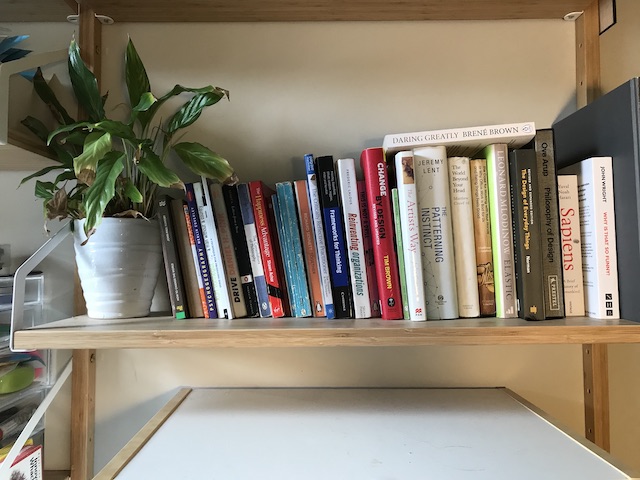This is the Constructivist Creativity Reading List. These are the books and book chapters that have changed the way I think about creativity and that inform the training that we do at Constructivist. Where a book relates to a specific course, I have made that link, but most of these books are generally applicable. I’ve also linked in other articles I’ve written about these topics where relevant.
The Implications of a Systems Perspective for the Study of Creativity – Mihalyi Csikszentmihalyi
Csikszentmihalyi’s chapter in the Handbook of Creativity (ed. R. Sternberg, Cambridge University Press) helped me shift my focus from thinking about the creativity of individuals to how creativity develops in teams. From this wider standpoint we start to think about how ideas are received and listened to, how information is transmitted, and how individuals access the broader pool of inputs of the whole team. This approach works well for thinking about how to develop creative thinking at a strategic level. My 2016 post, 9 ways to build creativity in your organisation, explores the application of this concept.
Motivation and Creativity – Mary Ann Collins and Teresa Amabile
Another chapter from the Handbook of Creativity, this text provides an excellent summary of the research into how internal and external factors influence the creativity of individuals. It’s hard not to conclude from reading this synthesis that we have got projects badly managed in engineering if we want to promote creative thinking. The concepts in this chapter make their way into our training on how to create the conditions for your own and your team’s creative thinking. Things like, how can you structure your day to make time for creative thought, undistracted by the torrent of emails that await you.
Time to Think: Listening to Ignite the Human Mind – Nancy Klein
This quick-to-read volume is hugely revealing about the way we talk to each other. Klein’s concept is that we do our best thinking when we are talking. So as listeners, one of the most important things we can do is let the other person do the talking, and not jump in with our ideas. Thinking about how we talk and how we listen fits nicely into conversations about how the creative system and how the link is strenghened beteween the creative individual and their audience. It’s a concept that we work with in our ‘how to run a great workshop workshop’ both in terms of how facilitators act, and what behaviours we encourage in the room. Once you’ve read this book you’ll be amazed by just how little people listen to each other.
Elastic: Flexible Thinking in a Constantly Changing World – Leonard Mlodinow
Mlodinow has written here a great summary of the neuroscientific understanding of our creative thinking. It is a fascinating read, and I intend to read it again soon. What i find particular helpful is his explanation of how the conscious and unconcsious mind relate to each other in the creative process. In our Introduction to Conceptual Design courses we introduce the ‘ask what if’ technique for idea generation. The thinking behind it is drawn from the concept, explained in this book, of there being filters that allow certain ideas through from our subconscious to our conscious and not others. The way this filter is set depends on the situation. The ‘ask what if’ technique tries to get us change the shape of that filter. For a playful summary of a range of the idea generation techinques we use, read my article ‘how to have ideas, guidance for engineers and other humans’.
Reinventing Organisations – Frederic Laloux
This is the book I’m referring to most often at the moment. It is a rich analysis of the stages of organisational development – from highly hierarchical to evolutionary organisations. Read it if you want to analyse how you think your organisation or team is working, and what sort of changes you could make to create a step change in how you work together. We use some of the concepts in this book to frame our workshops about how to develop a design strategy for organisations, and now it is a valuable resource to support the development of our training on ‘what to do after declaring a climate emergency.
The Design of Everyday Things – Donald Norman
I love this book. It’s one of those reads that just makes you look at things differently; one that makes you ask, ‘why have they done that like that’. It’s a book about design for usability. From a teaching design and creativity point of you, it is providing us with the sorts of requirements that clients don’t realise they want, but they soon complain about if they don’t have them. Think of it as a companion to building a good design brief.
What I’m reading next
I thought you might like to know what’s on my to-read pile. Once I’ve reviewed them I may add them to the creativity reading list.
- Daring Greatly – Brené Brown – I’m hoping to find in this thinking about developing confidence to express ideas in a hostile environment
- The Patterning Instinct – Jeremy Lent – Looks to be a rich crossover between systems thinking and anthropology
- Sapiens – Yuvla Noah Harari – my colleague Nick Francis said three times to me you’d better read this, and then he sent me a copy, so I guess I better had.
What would be on your creativity reading list?
What have you read that has taught you something about creativity and design? Do you have any recommendations for me or other readers ? Please post them in the comments below.

